Abstract
Objective:
Functional ankle instability (FAI) afflicts many athletes. Several causes of FAI have been implicated, including peroneal muscle weakness. Traditional musculoskeletal rehabilitation programs have focused on concentric muscle strength. The purpose of our study was to compare concentric and eccentric isokinetic and isometric eversion ankle strength measurements between subjects identified as having unilateral FAI and subjects having no history of inversion ankle sprain.
Design and Setting:
Employing a matched-pairs technique, subjects with no history of ankle injury were compared with subjects with unilateral FAI using isokinetic and isometric measures of eversion ankle strength. Strength testing was performed in a sports medicine clinic setting.
Subjects:
Forty-two subjects volunteered for this study: 21 subjects suffered from unilateral FAI (age = 19.3 ± 1.1 years, wt = 84.0 ± 9.5 kg, ht = 181.5 ± 9.2 cm), while 21 subjects served as matched-paired controls (age = 19.5 ± 1.2 years, wt = 82.5 ± 10.9 kg, ht = 179.5 ± 7.9 cm).
Measurements:
Ankle eversion concentric and eccentric strength (peak torque) was assessed at 0°/s, 30°/s, 60°/s, 90°/s, 120°/s, 150°/s, and 180°/s using an isokinetic dynamometer.
Results:
We found no significant differences in concentric, eccentric, or isometric eversion ankle strength between the 2 groups of subjects.
Conclusions:
The exact cause of FAI remains elusive. Based on our results, those who suffer from unilateral FAI do not appear to have eversion strength deficits. Unless clear evidence of weakness exists, clinicians may find that eversion strength training exercises are unnecessary. Future research should examine other causes of FAI, including reciprocal muscle group strength ratios and proprioception deficits.
Keywords: isokinetic, peak torque, eccentric, concentric
Full text
PDF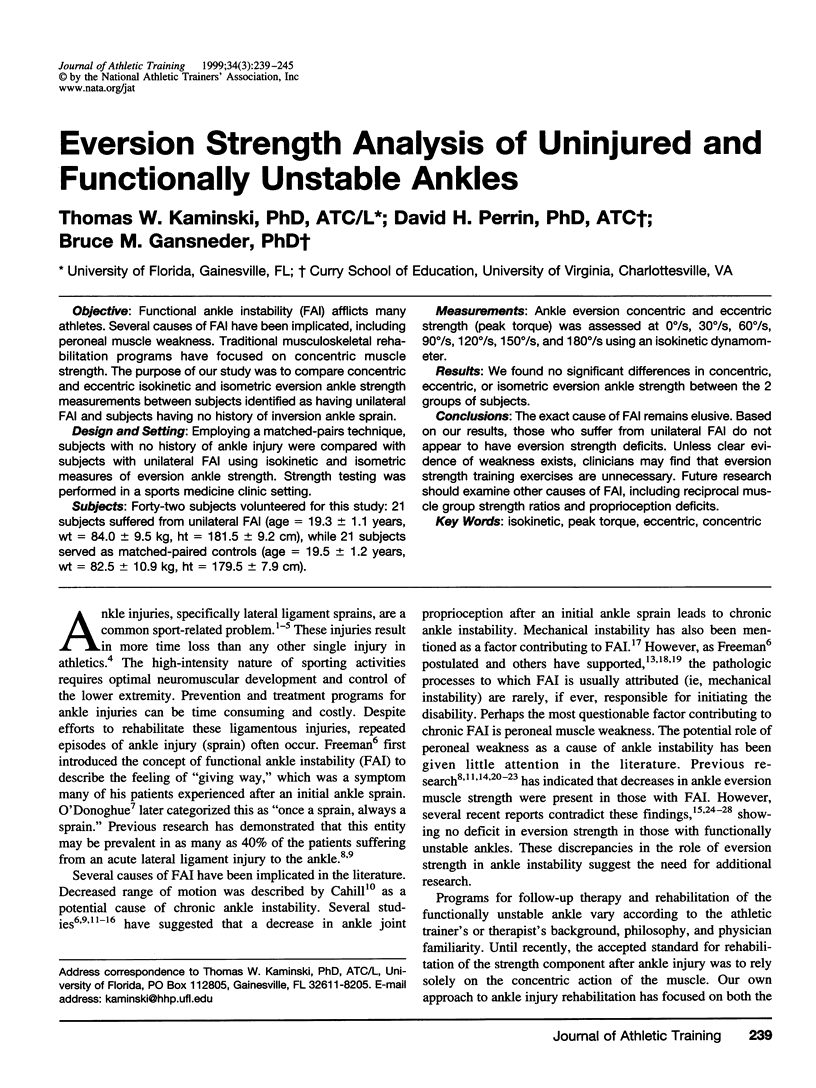
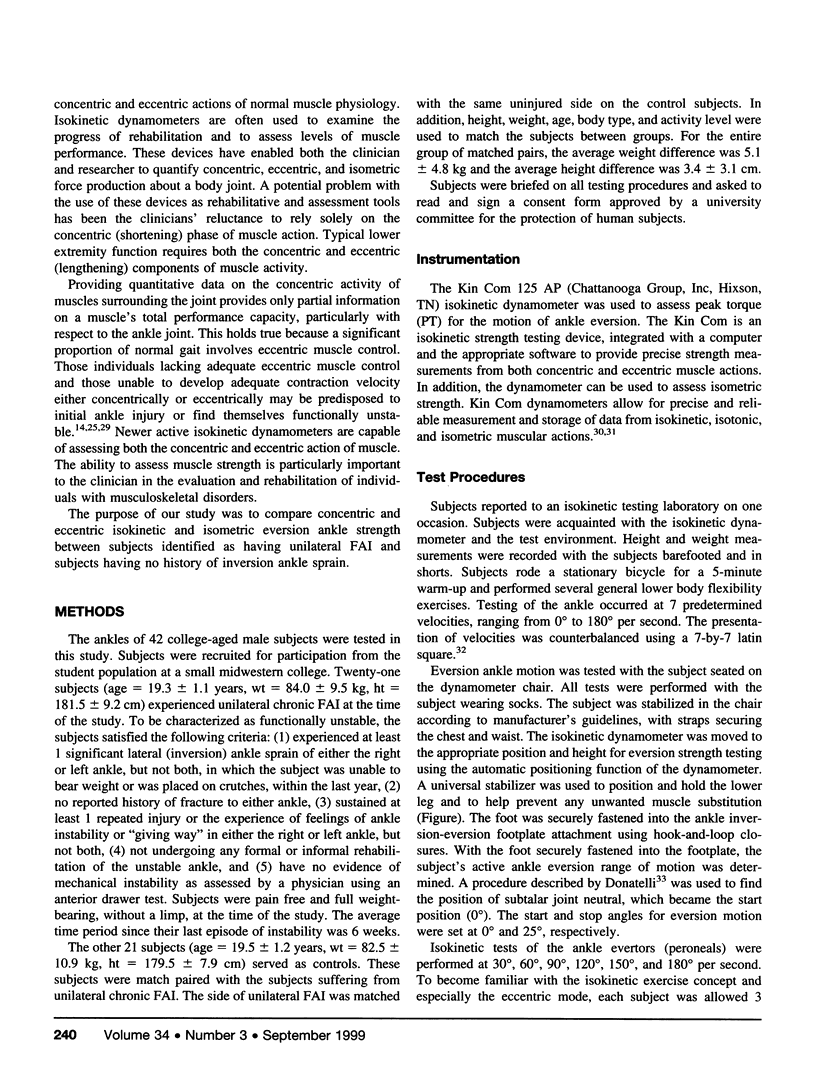
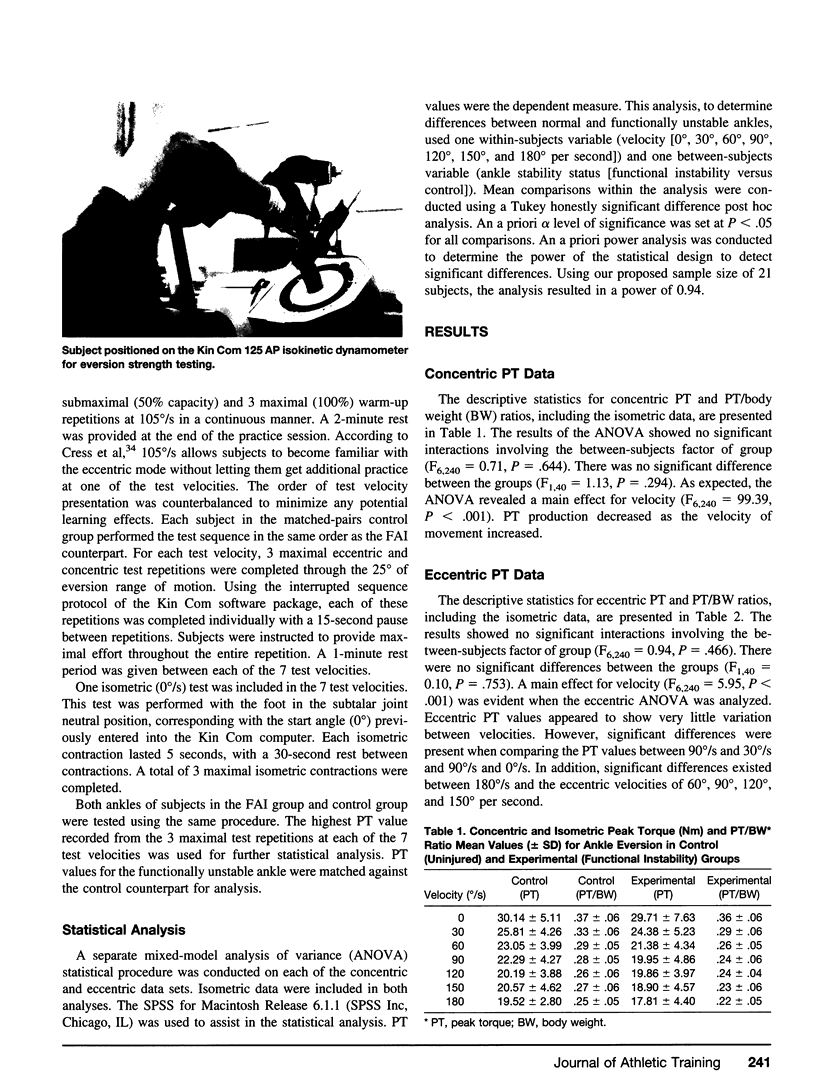
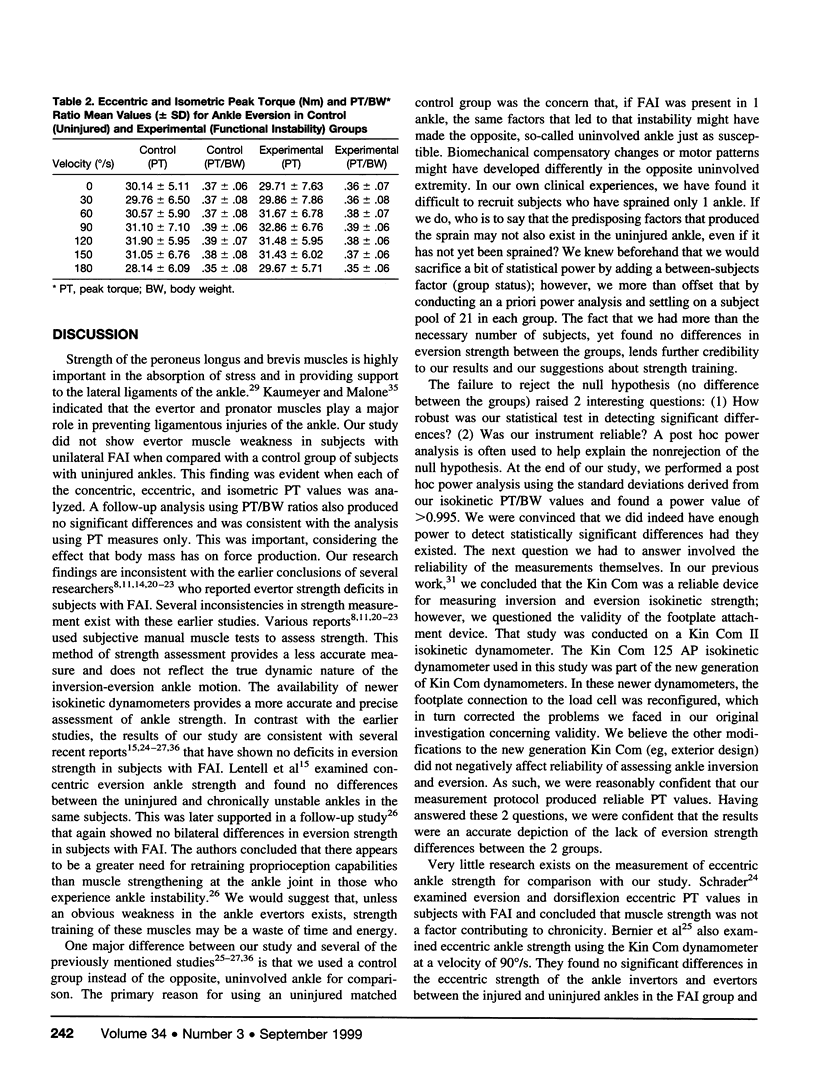
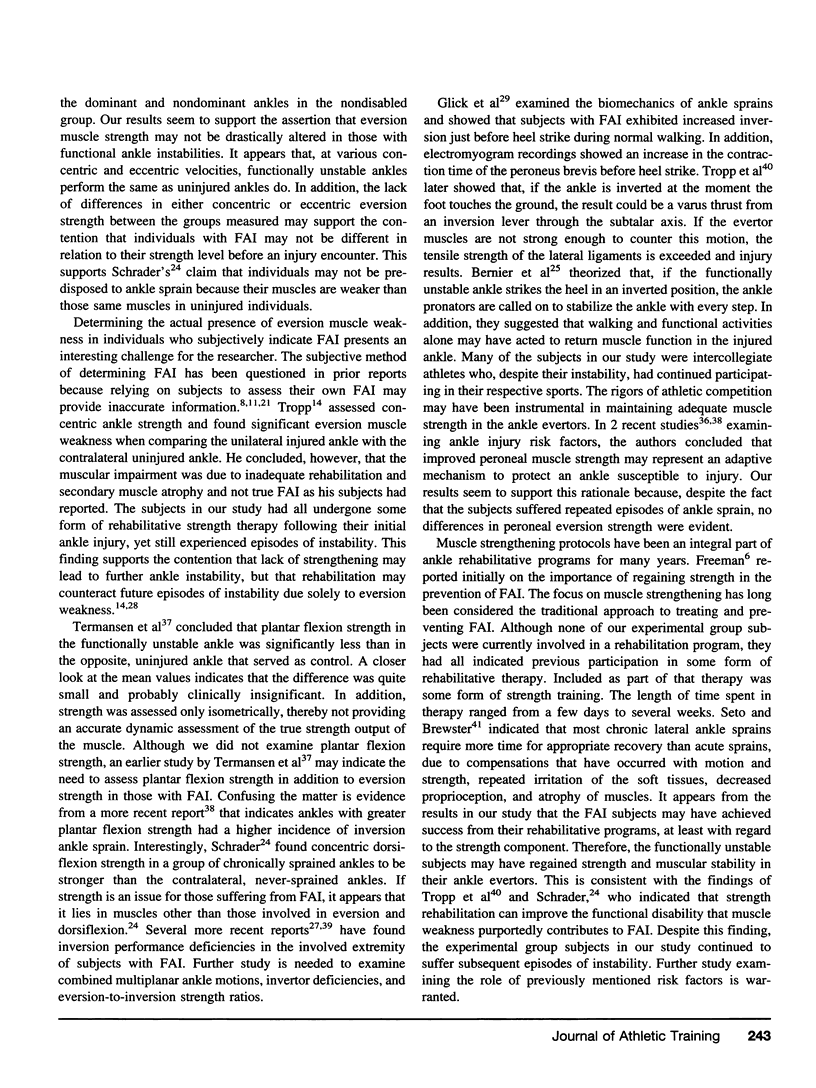
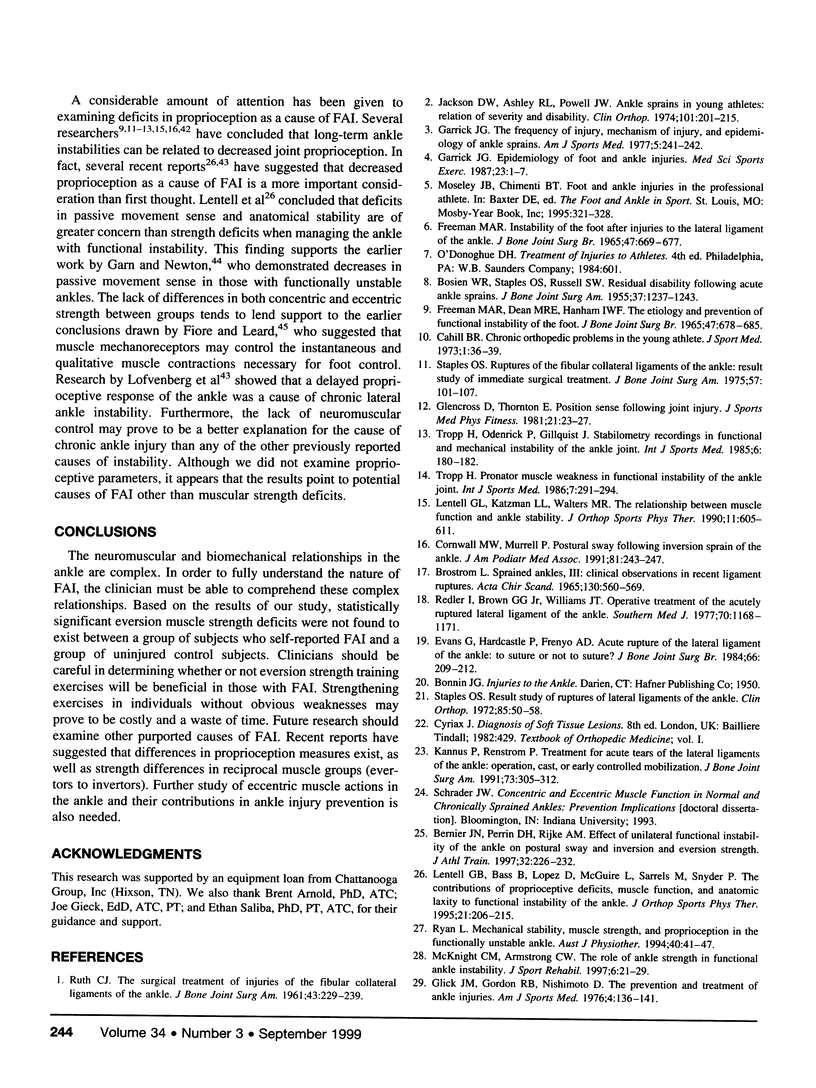
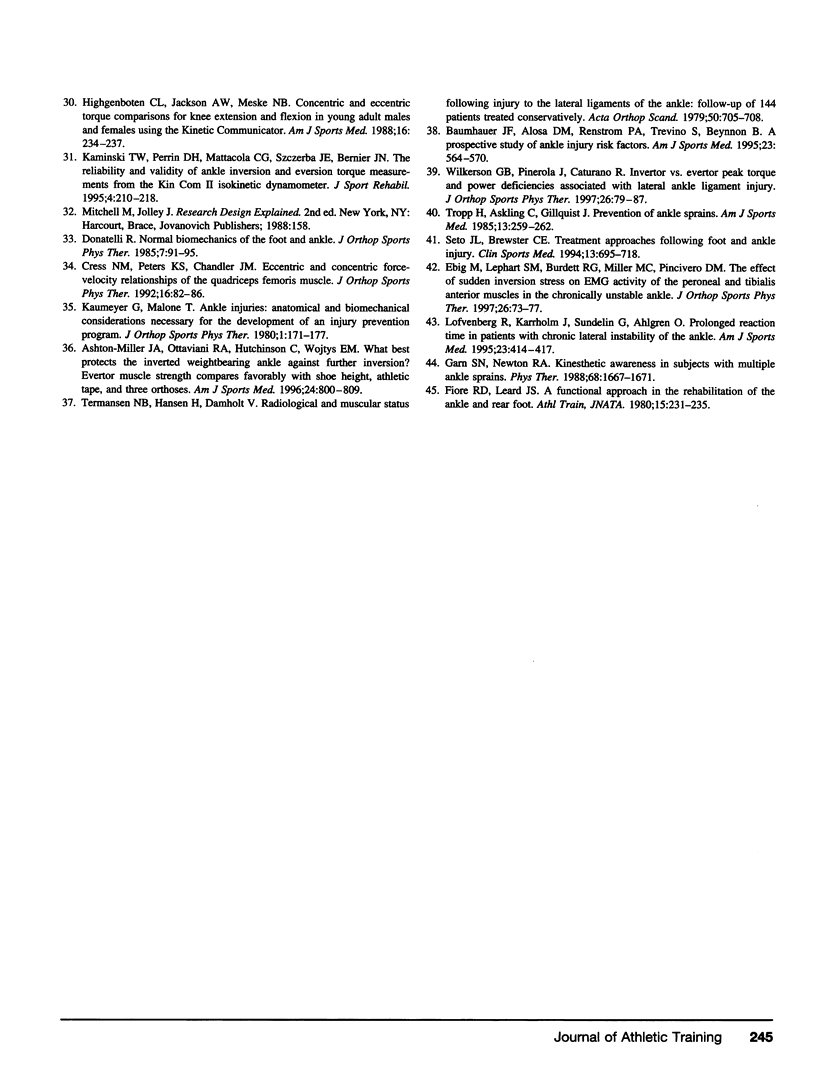
Images in this article
Selected References
These references are in PubMed. This may not be the complete list of references from this article.
- Ashton-Miller J. A., Ottaviani R. A., Hutchinson C., Wojtys E. M. What best protects the inverted weightbearing ankle against further inversion? Evertor muscle strength compares favorably with shoe height, athletic tape, and three orthoses. Am J Sports Med. 1996 Nov-Dec;24(6):800–809. doi: 10.1177/036354659602400616. [DOI] [PubMed] [Google Scholar]
- BOSIEN W. R., STAPLES O. S., RUSSELL S. W. Residual disability following acute ankle sprains. J Bone Joint Surg Am. 1955 Dec;37-A(6):1237–1243. [PubMed] [Google Scholar]
- Baumhauer J. F., Alosa D. M., Renström A. F., Trevino S., Beynnon B. A prospective study of ankle injury risk factors. Am J Sports Med. 1995 Sep-Oct;23(5):564–570. doi: 10.1177/036354659502300508. [DOI] [PubMed] [Google Scholar]
- Bernier J. N., Perrin D. H., Rijke A. Effect of unilateral functional instability of the ankle on postural sway and inversion and eversion strength. J Athl Train. 1997 Jul;32(3):226–232. [PMC free article] [PubMed] [Google Scholar]
- Broström L. Sprained ankles. 3. Clinical observations in recent ligament ruptures. Acta Chir Scand. 1965 Dec;130(6):560–569. [PubMed] [Google Scholar]
- Cahill B. R. Chronic orthopedic problems in the young athlete. J Sports Med. 1973 Mar-Apr;1(3):36–39. doi: 10.1177/036354657300100307. [DOI] [PubMed] [Google Scholar]
- Cornwall M. W., Murrell P. Postural sway following inversion sprain of the ankle. J Am Podiatr Med Assoc. 1991 May;81(5):243–247. doi: 10.7547/87507315-81-5-243. [DOI] [PubMed] [Google Scholar]
- Ebig M., Lephart S. M., Burdett R. G., Miller M. C., Pincivero D. M. The effect of sudden inversion stress on EMG activity of the peroneal and tibialis anterior muscles in the chronically unstable ankle. J Orthop Sports Phys Ther. 1997 Aug;26(2):73–77. doi: 10.2519/jospt.1997.26.2.73. [DOI] [PubMed] [Google Scholar]
- Evans G. A., Hardcastle P., Frenyo A. D. Acute rupture of the lateral ligament of the ankle. To suture or not to suture? J Bone Joint Surg Br. 1984 Mar;66(2):209–212. doi: 10.1302/0301-620X.66B2.6368563. [DOI] [PubMed] [Google Scholar]
- Freeman M. A., Dean M. R., Hanham I. W. The etiology and prevention of functional instability of the foot. J Bone Joint Surg Br. 1965 Nov;47(4):678–685. [PubMed] [Google Scholar]
- Freeman M. A. Instability of the foot after injuries to the lateral ligament of the ankle. J Bone Joint Surg Br. 1965 Nov;47(4):669–677. [PubMed] [Google Scholar]
- Garn S. N., Newton R. A. Kinesthetic awareness in subjects with multiple ankle sprains. Phys Ther. 1988 Nov;68(11):1667–1671. doi: 10.1093/ptj/68.11.1667. [DOI] [PubMed] [Google Scholar]
- Garrick J. G. The frequency of injury, mechanism of injury, and epidemiology of ankle sprains. Am J Sports Med. 1977 Nov-Dec;5(6):241–242. doi: 10.1177/036354657700500606. [DOI] [PubMed] [Google Scholar]
- Glencross D., Thornton E. Position sense following joint injury. J Sports Med Phys Fitness. 1981 Mar;21(1):23–27. [PubMed] [Google Scholar]
- Glick J. M., Gordon R. B., Nishimoto D. The prevention and treatment of ankle injuries. Am J Sports Med. 1976 Jul-Aug;4(4):136–141. doi: 10.1177/036354657600400402. [DOI] [PubMed] [Google Scholar]
- Highgenboten C. L., Jackson A. W., Meske N. B. Concentric and eccentric torque comparisons for knee extension and flexion in young adult males and females using the Kinetic Communicator. Am J Sports Med. 1988 May-Jun;16(3):234–237. doi: 10.1177/036354658801600306. [DOI] [PubMed] [Google Scholar]
- Jackson D. W., Ashley R. L., Powell J. W. Ankle sprains in young athletes. Relation of severity and disability. Clin Orthop Relat Res. 1974 Jun;(101):201–215. [PubMed] [Google Scholar]
- Kannus P., Renström P. Treatment for acute tears of the lateral ligaments of the ankle. Operation, cast, or early controlled mobilization. J Bone Joint Surg Am. 1991 Feb;73(2):305–312. [PubMed] [Google Scholar]
- Lentell G., Baas B., Lopez D., McGuire L., Sarrels M., Snyder P. The contributions of proprioceptive deficits, muscle function, and anatomic laxity to functional instability of the ankle. J Orthop Sports Phys Ther. 1995 Apr;21(4):206–215. doi: 10.2519/jospt.1995.21.4.206. [DOI] [PubMed] [Google Scholar]
- Löfvenberg R., Kärrholm J., Sundelin G., Ahlgren O. Prolonged reaction time in patients with chronic lateral instability of the ankle. Am J Sports Med. 1995 Jul-Aug;23(4):414–417. doi: 10.1177/036354659502300407. [DOI] [PubMed] [Google Scholar]
- Redler I., Brown G. G., Jr, Williams J. T. Operative treatment of the acutely ruptured lateral ligament of the ankle. South Med J. 1977 Oct;70(10):1168–1171. doi: 10.1097/00007611-197710000-00004. [DOI] [PubMed] [Google Scholar]
- Seto J. L., Brewster C. E. Treatment approaches following foot and ankle injury. Clin Sports Med. 1994 Oct;13(4):695–718. [PubMed] [Google Scholar]
- Staples O. S. Result study of ruptures of lateral ligaments of the ankle. Clin Orthop Relat Res. 1972;85:50–58. doi: 10.1097/00003086-197206000-00011. [DOI] [PubMed] [Google Scholar]
- Staples O. S. Ruptures of the fibular collateral ligaments of the ankle. Result study of immediate surgical treatment. J Bone Joint Surg Am. 1975 Jan;57(1):101–107. [PubMed] [Google Scholar]
- Termansen N. B., Hansen H., Damholt V. Radiological and muscular status following injury to the lateral ligaments of the ankle. Follow-up of 144 patients treated conservatively. Acta Orthop Scand. 1979 Dec;50(6 Pt 1):705–708. doi: 10.3109/17453677908991297. [DOI] [PubMed] [Google Scholar]
- Tropp H., Askling C., Gillquist J. Prevention of ankle sprains. Am J Sports Med. 1985 Jul-Aug;13(4):259–262. doi: 10.1177/036354658501300408. [DOI] [PubMed] [Google Scholar]
- Tropp H., Odenrick P., Gillquist J. Stabilometry recordings in functional and mechanical instability of the ankle joint. Int J Sports Med. 1985 Jun;6(3):180–182. doi: 10.1055/s-2008-1025836. [DOI] [PubMed] [Google Scholar]
- Tropp H. Pronator muscle weakness in functional instability of the ankle joint. Int J Sports Med. 1986 Oct;7(5):291–294. doi: 10.1055/s-2008-1025777. [DOI] [PubMed] [Google Scholar]



